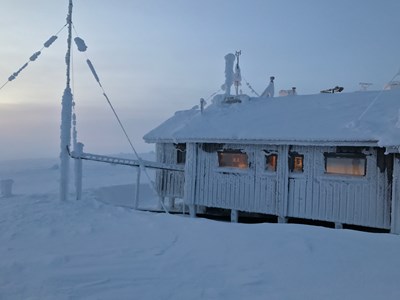The core issues that Professor Jeff Welker's projects are addressing consist of two broad Arctic themes. His research programs are designed to fit within several UArctic Thematic Networks, including; Arctic-Boreal Hub, Health and Well Being in the Arctic, Northern Food Security, Sustainable Production and Foraging of Natural Products in the North.
The Arctic Water Isotope Cycle
What are the patterns and processes of the modern Arctic water isotope cycle? How can we use land and ship based real-time sampling of water vapor isotopes to understand their function and response to synoptic weather variation and to the Barents region sea ice conditions?
This research program is a collaboration between UArctic, the University of Oulu, the University of Alaska Anchorage (UAA), the Finnish Meteorological Institute, the Natural Resources Institute of Finland and Pallas-Yllastunturi National Park. Welker’s team is using the Finnish Meteorological Institute’s Pallas Atmospheric Chemistry Station at 600m to continuously monitor the water vapor isotopes of the air. The goal is to determine how precipitation patterns and moisture sources are affected by observing factors such as wind directions, weather patterns, sea ice conditions at the moisture sources (i.e. Barents Sea), secondary water cycle processes during transport, and condensation and evaporation.

In the spirit of UArctic, Welker’s program has involved cross-training between young scientists in Alaska and Finland. Dr. Eric Klein from UAA has been training Dr. Kaisa Mustonen (University of Oulu-a UArctic Research Chair Postdoctoral Fellow) in real time laser-based isotope data acquisition skills, big data management and water isotope data interpretation. Collectively, they are developing visualization packages of the Arctic water isotope cycle. This modern understanding of the Arctic water isotope cycle will be applied to a whole new reanalysis program of climate records in Finland, Sweden and Norway that will be led by Dr. Hannah Bailey (University of Oulu- UArctic Research Chair Postdoctoral Fellow), assuring that we can fully place today’s weather and climate in the context of changes over the past decades, centuries and millennia.
Figure 1. UArctic Research Chair Welker's Arctic Water Isotope Cycle sampling at the Pallas, Finnish Meterological Institute's Sammaltunturi station. This station contributes to the Global Atmosphere Watch program (GAW), the International Carbon Observing System (ICOS), European Research Infrastructure for the observation of Aerosol, Clouds, and Trace Gases (ie. now including water vapor isotopes) (ARTRIS).
